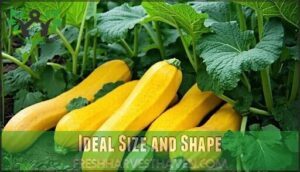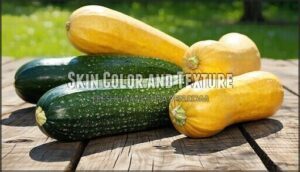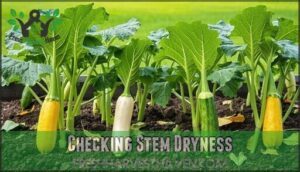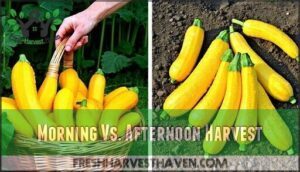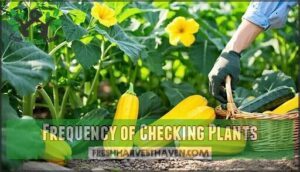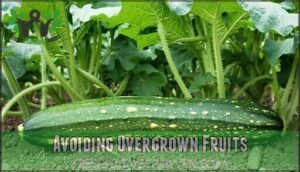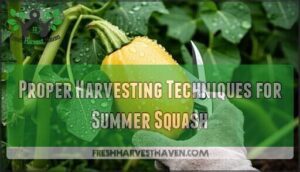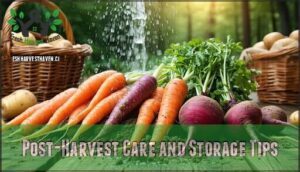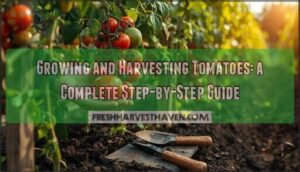This site is supported by our readers. We may earn a commission, at no cost to you, if you purchase through links.
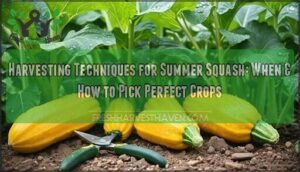 You’ll master harvesting techniques for summer squash by picking when fruits reach 6-8 inches long with glossy, tender skin that yields slightly to pressure. Use sharp cutting tools like scissors or pruners to make clean cuts at the stem.
You’ll master harvesting techniques for summer squash by picking when fruits reach 6-8 inches long with glossy, tender skin that yields slightly to pressure. Use sharp cutting tools like scissors or pruners to make clean cuts at the stem.
Harvest zucchini and yellow varieties at 6-8 inches, while patty pan squash works best at 2-4 inches across. Check your plants daily since summer squash grows fast. Handle gently to prevent bruising and move harvested squash to shade immediately.
The key is catching them before seeds harden – this keeps your plants producing all season long while ensuring peak flavor and texture.
Table Of Contents
- Key Takeaways
- Signs Your Summer Squash is Ready to Harvest
- Best Timing for Harvesting Summer Squash
- Proper Harvesting Techniques for Summer Squash
- Essential Tools for Harvesting Summer Squash
- Post-Harvest Care and Storage Tips
- Frequently Asked Questions (FAQs)
- How do you harvest summer squash?
- How do you pick a good summer squash?
- Should I cut the yellow leaves off my squash plant?
- What do squash plants look like when ready to harvest?
- Can summer squash be frozen for later use?
- What pests commonly damage summer squash during harvest?
- How do weather conditions affect harvest timing?
- Are summer squash blossoms safe to eat?
- When should diseased squash plants be removed?
- How do you prevent pests during harvest?
- Conclusion
Key Takeaways
- Harvest at the right size – Pick zucchini and yellow squash when they’re 6-8 inches long with glossy skin that yields slightly to pressure, and patty pan varieties at 2-4 inches across for optimal tenderness.
- Check plants daily – You’ll catch squash at peak quality and prevent them from becoming tough and seedy since summer squash grows rapidly during peak season.
- Use sharp cutting tools – Cut stems cleanly with pruning shears, scissors, or knives rather than twisting or pulling to prevent plant damage and disease.
- Handle gently and harvest frequently – Support fruits when cutting, move them to shade immediately, and pick regularly to keep plants producing all season long.
Signs Your Summer Squash is Ready to Harvest
You’ll know your summer squash is ready when it reaches 6 to 8 inches long with glossy, tender skin that yields slightly to gentle pressure.
Check the stem attachment point daily, as fresh squash will have a firm, green stem rather than a dried or woody one.
Ideal Size and Shape
You’ll know your summer squash is ready when it reaches 6-8 inches for zucchini or yellow varieties. Different squash variety types have ideal harvest sizes – patty pan should be 2-4 inches across.
Growth factors like weather affect timing, but ripe summer squash feels firm yet tender. Harvest before seeds harden for best culinary uses and garden harvest success.
Skin Color and Texture
Looking at your summer squash, you’ll notice skin glossiness signals peak ripeness. Dark, glossy green skin indicates perfect harvesting time for vegetables like zucchini.
Here are key texture changes to watch for:
- Skin Glossiness – Shiny, unblemished surface shows ideal harvest timing
- Rind Thickness – Tender skin yields slightly to gentle pressure
- Blemishes Impact – Smooth texture without soft spots or discoloration
Varietal differences affect appearance, but these harvesting tips apply universally for your garden harvest.
Checking Stem Dryness
Check stem dryness by examining where the summer squash connects to the vine. Dry, brown stems indicate peak ripeness and proper harvesting timing. Fresh, green stems suggest the squash needs more time.
Stem moisture levels directly affect storage implications and disease prevention. Optimal squash size is also a key indicator of ripeness.
Properly dried stems guarantee better post-harvest longevity for your vegetables.
Best Timing for Harvesting Summer Squash
You’ll want to harvest summer squash at the right moment to enhance flavor and texture.
Check your plants daily once they start producing, and pick fruits when they’re 6-8 inches long for ideal tenderness.
Morning Vs. Afternoon Harvest
Morning harvesting delivers ideal sugar content and plant hydration for summer squash. Temperature impact and sun exposure affect quality substantially.
- Early morning: Harvest after dew dries but before 10 AM for peak freshness
- Temperature advantage: Cooler conditions preserve crispness and prevent wilting
- Sugar concentration: Night’s rest maximizes natural sweetness in vegetables
- Pollination timing: Morning harvesting doesn’t disrupt bee activity for continued production
Frequency of Checking Plants
Your summer squash harvesting success depends on establishing a consistent monitoring routine. Check your plants every two to three days during peak growing season for ideal growth cycle management. This frequency allows for early problem detection of pest and disease issues before they impact your vegetables. Regular Plant Check Intervals prevent fruits from becoming overripe while ensuring proper harvesting timing throughout your garden’s productive period.
| Monitoring Schedule | Growing Conditions | Harvest Quality |
|---|---|---|
| Daily checks | Hot, humid weather | Premium tender fruits |
| Every 2-3 days | Normal conditions | Good quality harvesting |
| Weekly or less | Cooler temperatures | Risk of tough, seedy squash |
Avoiding Overgrown Fruits
Overgrown vegetables lose their tender texture and develop tough, woody flesh unsuitable for most culinary uses. You’ll notice mature fruit becomes seedy and bitter, making them poor choices for harvesting.
Focus on quality over quantity by picking zucchini at 6-8 inches when skin yields slightly to pressure. This practice enhances companion planting systems and improves overall pest management in your garden.
Proper Harvesting Techniques for Summer Squash
You’ll need sharp cutting tools and gentle handling techniques to harvest summer squash without damaging the plant or fruit.
Using scissors, pruners, or knives ensures clean cuts that prevent disease while protecting your hands from the plant’s rough stems.
Choosing The Right Cutting Tools
Sharp pruning shears with ergonomic grips become your best friend for harvesting summer squash. Look for blade material like stainless steel that resists rust and maintains cutting precision. Handle ergonomics reduce hand fatigue during extended garden sessions. Safety features and proper cutting angle protect both you and your vegetables.
Regular tool maintenance ensures consistent crop quality throughout the harvesting season. Some gardeners find scissors are also useful for certain harvesting tasks.
Using Scissors, Pruners, or Knives
Whether you grab scissors, pruners, or knives for your harvesting method, blade sharpness matters most for these summer delicacies. Sharp tools create clean cuts and reduce plant stress in your garden.
Use ergonomic grips to prevent fatigue during extended harvesting sessions. Consider tool sterilization between vegetables to prevent disease spread.
Proper cutting angles preserve tool longevity while maximizing efficiency. You can find suitable summer squash pruners online.
Gentle Handling to Prevent Damage
Think of your squash like precious cargo during harvesting. Support each fruit with both hands when cutting to prevent dropping and bruising.
Clean harvested vegetables gently with cool water, removing dirt without scrubbing. Use shallow containers for careful transport, avoiding stacking that crushes delicate squash blossoms.
Proper handling education ensures superior crop quality throughout your harvesting method.
Essential Tools for Harvesting Summer Squash
You’ll need sharp, clean cutting tools to harvest your summer squash without damaging the plants or fruits.
Quality pruning shears or garden scissors make clean cuts through tough stems while protecting your hands from prickly leaves.
Fiskars Multi Snip With Sheath

The Fiskars Multi Snip comes with a protective sheath for safe vegetable harvesting storage. Its snip blade quality features precision-ground stainless steel that cuts zucchini stems cleanly. The ergonomic design reduces hand fatigue during harvesting methods.
Multi-purpose uses include cutting squash blossoms and small vegetables. Sheath durability protects the blade when not in use. Cleaning methods involve simply wiping blades after harvesting.
Other Recommended Pruners and Shears
Corona ClassicCut and Felco models dominate vegetable harvesting recommendations. These Ergonomic Pruners feature comfortable grips that reduce strain during frequent picking sessions.
Choose Bypass vs Anvil designs based on crop needs—bypass cuts cleanly through tender squash stems, while anvil works for thicker material.
High-carbon Blade Materials offer exceptional edge retention for continued use. Quality harvesting tools improve Crop Quality by preventing stem crushing that leads to plant damage.
Maintenance and Safety Tips
Clean your tools after each harvest session to prevent spreading plant diseases between crops. Store tools in dry locations to prevent rust and maintain garden hygiene throughout the growing season.
Sharp blades reduce plant damage and make cuts cleaner, so sharpen pruners regularly. Always cut away from your body and wear gloves for injury prevention.
Consider that summer squash varieties offer distinct advantages.
Post-Harvest Care and Storage Tips
Once you’ve harvested your summer squash using proper techniques, you’ll want to handle them carefully to maintain quality and extend storage life. Gentle handling prevents bruising, while proper storage conditions keep your squash fresh for several days in the refrigerator.
Minimizing Bruising and Surface Damage
After selecting your proper tools, focus on gentle handling techniques to protect your harvest. Summer squash bruises easily, so treat each fruit like you’re handling eggs. Handle harvested squash with care to prevent surface damage that shortens shelf life. Proper harvesting can reduce mechanical damage and bruising.
- Use soft liners like towels in collection baskets to cushion fruits during transport
- Support the squash from underneath when lifting rather than grabbing from the top
- Avoid dropping or tossing squash into containers, even from short distances
- Stack carefully with heavier fruits on bottom and lighter ones on top
- Implement quick cooling by moving harvested squash to shade immediately after picking
Optimal Storage Conditions
Store your fresh summer squash at 45-50°F with 90-95% humidity levels for ideal shelf life. Use storage containers with adequate air circulation to prevent moisture buildup while maintaining peak flavor. Temperature control prevents chilling injury below 41°F.
To maintain freshness, it’s best to select squash with a shiny and firm rind. These best practices for postharvest handling extend your harvest vegetables’ quality up to seven days.
Handling Damaged or Overripe Squash
Damaged garden produce doesn’t mean total loss. You can salvage parts of overripe zucchini for culinary uses like breads or soups. Remove affected areas and use healthy portions immediately.
Don’t let overripe squash go to waste—salvage the good parts for cooking instead
Save seeds from mature squash for next season’s harvest.
Compost unusable pieces to avoid pest attraction, but remove squash blossoms first since they’re edible and delicious when stuffed or fried.
Frequently Asked Questions (FAQs)
How do you harvest summer squash?
Use sharp knives or pruning shears to cut summer squash stems when they’re 6-8 inches long. Harvest frequently in early morning for best flavor and texture.
How do you pick a good summer squash?
You’ll want young, tender squash that’s 6-8 inches long with glossy, unblemished skin.
Avoid oversized ones—they’re tough and seedy. The skin should yield slightly to gentle pressure but still feel firm overall.
Should I cut the yellow leaves off my squash plant?
Yellow leaves on squash plants are like nature’s yellow flags – they’re signaling something’s up. You should remove yellowing leaves that are diseased, damaged, or blocking airflow, but keep healthy ones that still photosynthesize effectively.
What do squash plants look like when ready to harvest?
Summer squash plants are ready when you’ll see firm, glossy-skinned fruits about 6-8 inches long. The skin should give slightly under gentle pressure but still feel tender and smooth.
Can summer squash be frozen for later use?
Like storing sunshine in your freezer, you can freeze summer squash for winter meals. Blanch sliced squash for two minutes, cool in ice water, drain thoroughly, then freeze in airtight containers for up to eight months.
What pests commonly damage summer squash during harvest?
Common culprits you’ll face include squash bugs, which cause wilting and plant death, squash vine borers, aphids, and cucumber beetles.
These pests particularly target young, tender plants but can damage mature crops too.
How do weather conditions affect harvest timing?
Weather directly impacts your harvest timing. You’ll need to pick before rain, which causes split skin and rot. Hot, dry conditions accelerate ripening, requiring daily checks for ideal tenderness.
Are summer squash blossoms safe to eat?
Yes, you can eat summer squash blossoms! They’re completely edible and quite delicious.
**Pick male blossoms (they’ve thin stems) in early morning.
** Stuff, batter, and fry them for a garden-to-table treat.
When should diseased squash plants be removed?
Remove diseased squash plants immediately when you spot yellowing leaves, wilting, or visible fungal growth. Early removal prevents disease spread to healthy plants and protects your entire garden from contamination.
How do you prevent pests during harvest?
You’ll want to inspect plants regularly, remove affected leaves immediately, and use row covers during vulnerable growth periods. Apply beneficial nematodes to soil and encourage natural predators like ladybugs.
Conclusion
Mastering harvesting techniques for summer squash transforms your garden from overwhelming abundance to manageable bounty. Frequent harvesting keeps plants producing through the entire growing season.
You’ll consistently pick tender, flavorful squash by checking plants daily and cutting at proper size indicators. Sharp tools prevent plant damage, while gentle handling preserves fruit quality.
These proven methods guarantee you’ll enjoy peak-quality squash rather than oversized, seedy disappointments that often plague novice gardeners.
- https://www.backyardboss.net/harvest-your-summer-squash/
- https://www.gardeningknowhow.com/edible/vegetables/squash/when-to-harvest-squash-best-time-to-pick-winter-or-summer-squash.htm
- https://extension.purdue.edu/foodlink/food.php?food=summer+squash
- https://cucurbits.ces.ncsu.edu/about-cucurbits/growing-cucurbits/variety-trials/2020-zucchini-squash-cultivar-evaluations/
- https://www.chelseagreen.com/2023/harvest-store-and-cure-squash/

